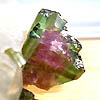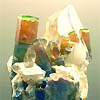- sale
- new items
- lovely beads
- wedding beads
- beads for teens
- for custom order
- newsletter
- recognition
- testimonials
- birthstones
- zodiac signs
- jewelry guide
SHOP BAG
![]() in your bag 0 items
in your bag 0 items
Tourmaline is a fascinating mineral (to be exact, group of minerals) that can actually exhibit two or more colors in one crystal. It possesses one of the widest color ranges, reproducing every conceivable color in the universe. The name "tourmaline" comes from the Singhalese word TURAMALI or TORAMALLI, meaning "stone attracting ash" (a reference to its pyroelectric properties) or according to other sources "mixed gemstones". For a while the name "tourmaline" was applied to different gemstones found in Ceylon (now Sri Lanka).
Brightly colored tourmalines were brought to Europe from Sri Lanka in great quantities by the Dutch East India Company to satisfy a demand for curiosities and gems. At that time the gem schorl that looks like tourmaline was known in Europe, but it was not realized that both stones belong to the same mineral group.
The most common species of tourmaline is schorl. It may account for 95% or more of all tourmaline in nature. The early history of the mineral schorl shows that the name "schorl" was in use prior to 1400 AD because a village, that had a nearby tin mine where black tourmaline was found, known today as Zschorlau (in Saxony, Germany) was then named "Schorl" (or minor variants of this name).
As it was said, tourmaline has a variety of colors. Usually, tourmalines are black to bluish-black to deep brown, brown to yellow, blue, green, red, yellow, pink etc. Rarely, it is colorless. Bi-colored and multicolored crystals are common, reflecting variations of fluid chemistry during crystallization. Crystals may be green at one end and pink at the other, or green on the outside and pink inside: this type is called watermelon tourmaline. Some forms of tourmaline are dichroic, in that they change color when viewed from different directions.
Gem and specimen tourmaline is mined chiefly in Brazil and Africa. Some placer material suitable for gem use comes from Sri Lanka. In addition to Brazil, tourmaline is mined in Tanzania, Nigeria, Kenya, Madagascar, Mozambique, Namibia, Afghanistan, Pakistan, and Sri Lanka, and Malawi. Some fine gem and specimen material has been produced in the US, with the first discoveries in 1822, in the state of Maine (raspberry pink-red as well as minty greens tourmaline). California became a large producer of tourmaline in the early 1900s (bright pinks, as well as bicolors).
Tourmaline species and varieties
1. Dravite species: from the Drave district of Carinthia (Austria)
- dravite - dark yellow to brownish black
2. Schorl species:
- schorl - bluish or brownish black to black
3. Elbaite species: named after the island of Elba, Italy
- rubellite - rose or pink (from ruby)
- indicolite - dark blue (from indigo)
- "Brazilian sapphire" - light blue
- "Brazilian emerald" or verdelite - green
- achroite - colorless (from the Greek word for "colorless")
Tourmaline facts
1. The Empress Dowager Tz'u Hsi, the last Empress of China, loved pink tourmaline and bought large quantities for gemstones and carvings from the then new Himalaya Mine, located in San Diego County, California.
2. Native Americans have used pink and green tourmaline as funeral gifts for centuries.



